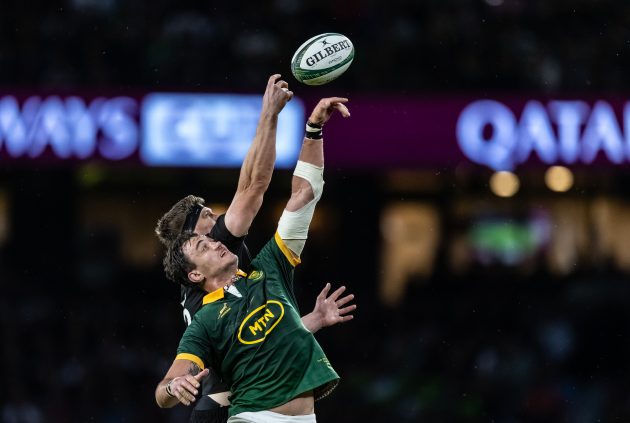Scarlets, Wales and Lions great Ken Owens takes an analytical look at how the Springboks lineout defence worked against the All Blacks
The Springboks lineout didn’t compete too much in the Rugby Championship or the warm-ups until they played against New Zealand. At Twickenham, their lineout defence showed a different picture leading into the Rugby World Cup.
They utilise the back five of the scrum, who are all genuine jumping options and very athletic. This can create pressure for the opposition caller. But the strength of their defensive lineout is their zonal defence. This basically means that they get into two pods, shift and move late, create disruption, and paint a changing picture for the opposition.
The defenive Springboks lineout moving late obviously puts pressure on the caller to make the right call. But it also then the hooker, because obviously there are moving defensive targets up in front of him.
One thing they did at Twickenham was to set traps for New Zealand.
They would give them, say, the back of the lineout or the middle or the front, and then shift late. This will of course put pressure on the drill of the lineout and for the caller. Consequently, they got a number of steals, but even if they didn’t they were getting pods in the air. So even though at times New Zealand we’re winning the ball, Pieter-Steph du Toit and Franco Mostert in particular – and Eben Etebeth at times – were still getting up, making delivery of the ball untidy.
This will cause disruption when you are trying to set-up mauls, for example. New Zealand, when they were trying to run some breakout plays, they weren’t getting clean ball off them. New Zealand rely on set-piece, first-phase ball to get into their shape and and launch plays off, and they just didn’t get that at all.
As a hooker, if you know they will have jumpers going up, that there’s gonna be distraction, you’re thinking ‘I need to be hitting double tops’. You could really be pushing it to the max which then creates a little bit of doubt, a little bit more pressure. And that’s when you start seeing throws touching fingertips or going slightly over. And then it pressures the drill of the opposition. So sometimes South Africa didn’t need to do too much because the pressure was already put on onto New Zealand.

Disrupted lineout ball (Getty Images)
The ways to counter this are threefold. It’s backing your drill, to say you can win the ball in the air, in the space, with max drill speed to get up before them. Playing with an even higher tempo is another option. Or you can go the other way, slowing it right down and waiting for them to change the picture before making the call.
What can work against South Africa’s lineout defence, which we’d used a lot on the British & Irish Lions tour and when when we’ve played against them as Wales in the past, is reacting to them leaving the front option.
You’ll see a couple of times where they’d be in a pod of three with Steven Kitshoff, Mostert and Frans Malherbe. They’ll shift late, which will leave the front option on and if you’ve got a good athlete, a good ball handler, you can you can win the ball there and get a push delivery and get the ball going, or even just hit the prop on the floor. And if you’re happy to take the easy option, and continue to take it, and make them change their defensive set-up that can also open up options later on.
But one of the most impressive things that came out of the game against New Zealand was the Sprinboks lineout transitioning. Even though they would be getting up in the air to disrupt, if New Zealand still got it, what was impressive was their reactions after that. Whether it was Malcolm Marx tail-gunning or Siya Kolisi getting off the back or the guys getting down and getting stuck into the mauls – New Zealand got no joy out of their mauls.
Related: Why Frans Malherbe is a world great
Du Toit was going up, then he’d be down, hit the maul and causing all sorts of carnage. It’s all about the second job – the ‘work’ as we’d call it. Once you’ve done your first job, if it hasn’t worked it’s then quickly onto our second job.
With regards to how the Springboks lineout is set up, Frans Malherbe can epitomise that second job. If he is near the middle of the lineout, he is obviously a slightly shorter guy but a guy who is built to hit malls really hard and disrupt things. So he’s in a position to get a good lift because he’d be one of the strongest guys, so getting Mostert up to cause pressure. But then he also able to to affect the maul.
Download the digital edition of Rugby World straight to your tablet or subscribe to the print edition to get the magazine delivered to your door.
Follow Rugby World on Facebook, Instagram and Twitter.





